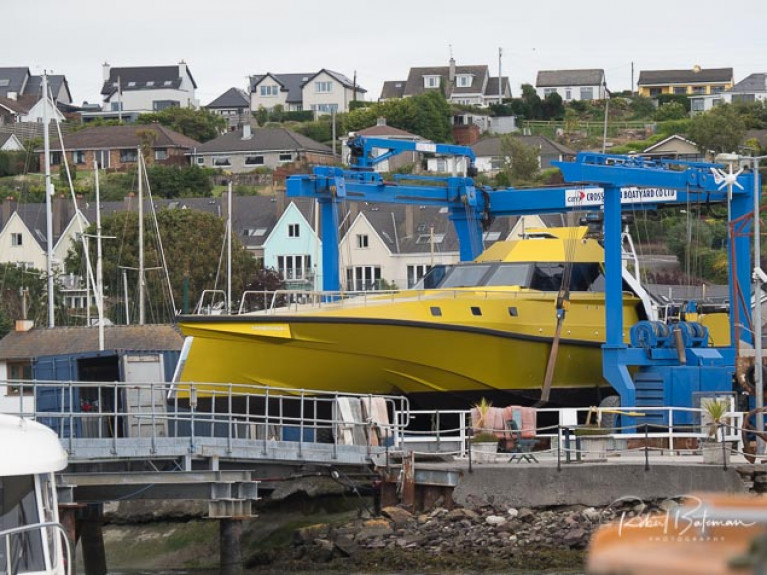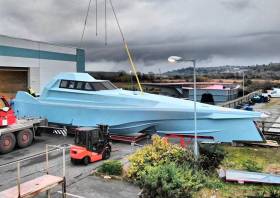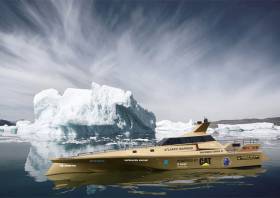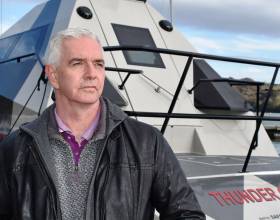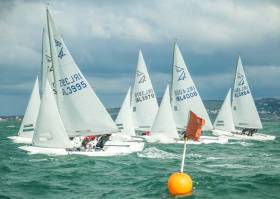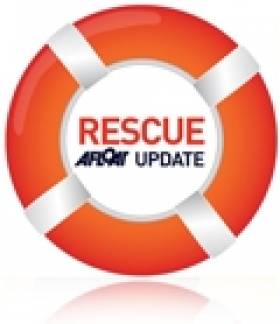Displaying items by tag: Frank Kowalski
Safehaven Marine's Frank Kowalski has announced that his planned Trans-Atlantic record attempt this year in Thunder Child II has been postponed.
Speculation mounted this week when the asymmetrical catamaran was lifted out of the water in Cork Harbour that it might be the start of record bid preparations.
Kowalski told Afloat 'Regretfully Safehaven Marine have had to postpone our planned Trans-Atlantic record attempt this year in Thunder Child II. This is due to the COVID 19 crisis and the global logistical and travel restrictions in place'.
It had previously been indicated that between July and August 2020 the same five-member crew that set a record time Round Ireland also aboard Thunder Child II, would attempt an unprecedented 4,500 km transatlantic route from Killybegs to Newfoundland via refuelling stops at Greenland and Iceland.
Kowalski also told Afloat via social media: "Due to the very small Greenland sea ice and North Atlantic weather window that existed for us to make the attempt, sadly it is not going to be possible for us to undertake the voyage this year".
Thunder Child II Taking Shape At Safehaven Marine
Thunder Child II is finally taking shape at Cork-based performance boatbuilders Safehaven Marine, with “another couple of more months” go before launch for sea trials in the New Year.
As previously noted on Afoat.ie, the XSV20 design developed over the past year crosses a wave-piercing monohull with a catamaran and is optimised for cutting through 4,000km of Atlantic sea with the aim of setting a new powerboat world record.
Safehaven Marine — with its design HQ in Cork Harbour and boatbuilding yard in Youghal — is also busy with its pilot boat commissions, the latest coming from Puerto Rico.
So finally after a year in development 'Thunder Child II' takes her shape. She looks pretty cool. Just another couple of more months work till her launch. pic.twitter.com/vXGnqKioKj
— Safehaven Marine (@SafehavenMarine) November 23, 2018
Safehaven Announces ‘Thunder Child 2’ Atlantic Record Attempt
#WorldRecord - Safehaven Marine has announced a new powerboat world record attempt — this time across the Atlantic.
Frank Kowalski, managing director of the Cork Harbour boatyard, has developed what the Irish Examiner is calling a “radical” new hull for Thunder Child 2.
Crossing a wave-piercing monohull with a catamaran hull, the new design promises to cut through more than 4,000km of Atlantic seas in under four days.
In May, Safehaven previewed the design of what’s officially the XSV20, which has completed scale model tests ahead of construction of the first demonstrator model due for launch in the new year.
Kowalski says the XSV20 was developed “in one’s endless pursuit of travelling fast in rough seas”.
And he will be putting that statement to the test next summer, between July and September, across the ‘northern route’ from Newfoundland to Killybegs via Greenland and Iceland for refuelling.

The Safehaven MD and his crew set a new round Ireland record in summer 2017 with the original Thunder Child, a Barracuda XSV 17 interceptor that can reach speeds of 60 knots.
Thunder Child 2 will come with its predecessor’s military-grade navigation technology and shock-dampening seats, and will be powered by four Caterpillar C8.7 650hp engines providing top speeds in excess of 50 knots.
Aside from the company’s record-breaking plans, Safehaven recently launched its third pilot vessel for Malta Maritime Pilots in Valletta.
The Interceptor 48, Juliet, is also the 35th Safehaven pilot boat to enter ports service internationally.
Number 36 is due next month when Safehaven delivers another Interceptor 48 for the Port of Leixões in Portugal under a contract with marine services firm Svitzer.
Frank Kowalski, Safehaven Marine: A Man About Speed
Hello, Tom MacSweeney here, and thank you for tuning in to the MacSWEENEY PODCAST.
As a marine correspondent I’m fortunate to meet great people who do amazing things… One of them is Frank Kowalski, the Managing Director of Safehaven Marine which designs and builds boats, but not just any boats……
These are at the leading edge of fast boat technology….. naval and military craft, with stealth capabilities, which can approach illegal operators at sea without being detected by radar…
On my Podcast this week, he tells me why he is attempting to set a world speed record in one of his boats, the powerfully named THUNDER CHILD, around Ireland and Rockall, which has never been attempted before. The record is underway details here
Listen to the Podcast below
Sailing is Recovering After 'Famine Years' Says ISA CEO
Sailing is in recovery mode after six or seven years of famine. That is the opinion of the Chief Executive of the Irish Sailing Association, Harry Hermon.
This week he told me frankly that the sport had struggled over the past few years, particularly from the effects of the recession. Yacht clubs had suffered and the larger clubs had been hit hard he said. But over the last year or two more boats and more people have come into the system.
“There is more positivity out there now and that is really good. Things are looking good at the moment.”
Sailing has been bedevilled by the image of being an elitist sport and he said that the ISA was dealing with this.
Listen to my interview with Harry Hermon here on this Podcast edition of THIS ISLAND NATION maritime radio programme below which also hears from a company on the East Cork coastline that is setting new trends in the design of special boats including one with “stealth” capabilities to conceal its presence when used by security, Naval and military forces Safehaven Marine at Youghal is also planning to set a new speed record around Rockall this Summer, which are outlined by the man who set it up, Frank Kowalski.
Cool as a cucumber in some very scary seas, watch Irish boat builder Frank Kowalski put two of his new Barracuda vessels through their paces off the Daunt Rock outside Cork Harbour on the South coast of Ireland. The video shows a 13m Barracuda II on rough weather sea trials alongside an 11m Barracuda I in 'Storm Desmond' with 6m seas and 60mph+ winds.
Safehaven Marine, based in Youghal, took advantage of the storms to perform rough weather sea trials of new vessels including a Wildcat 60 catamaran, and 18.5m ocean research vessel.
Read Afloat's previous posts on Safehaven's range of vessels here
New Irish Built Search & Rescue Craft Capsize Tested with Designer Inside
The Cork Harbour based Safehaven Marine, specialist builders of pilot boats and rescue vessels have undertaken probably an industry first, by capsizing their latest Interceptor 48 Pilot / S.A.R. vessel in a live condition with two crew inside during the roll over.
In the ultimate expression of confidence in the vessels design and integrity, Safehaven's managing director and designer, Frank Kowalski, volunteered to be inside the vessel during the roll over. Strapped in with a full harness at her helm position he commented "it was a bit stressful when she was over at 90 degrees about to go over, and the motion past 180 during recovery was pretty violent, but it went off without a problem"
The above youtube video Safehaven made with multiple cameras both inside and outside during the test makes very interesting viewing in clearly showing the forces involved.
Look closely and you can see her crew inside at the time.

